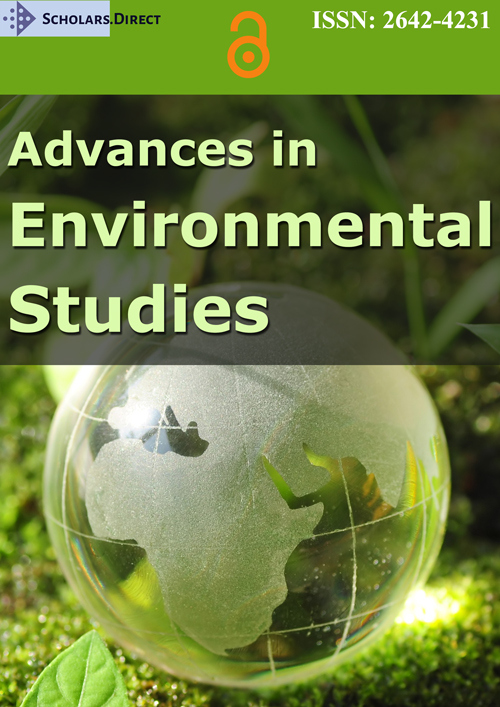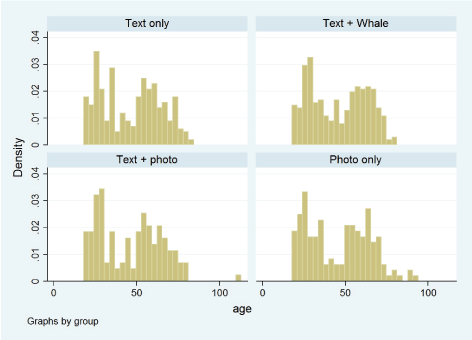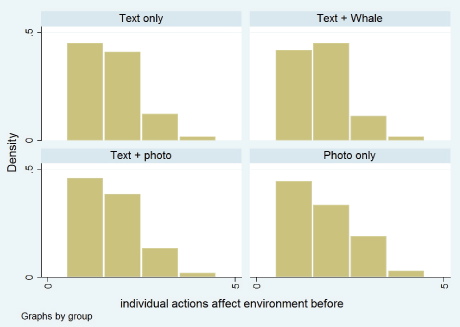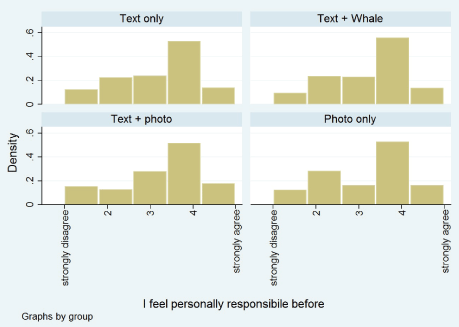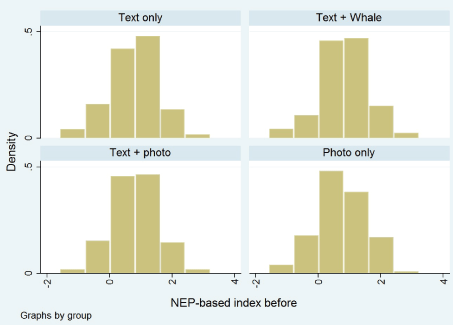Environmental Art and Environmental Beliefs: The Case of Plastic Bag Pollution in Oceans
Abstract
This paper reports the results of two experiments exploring the impact of exposure to environmental art on environmental beliefs, using images of plastic bag pollution in oceans. Even though the experimental design investigates only the immediate impact of a brief exposure to artistic images, the design controls well for other factors that might influence changes in environmental beliefs. This study is one of the few to directly estimate the effect of environmental art and it is the first to use elements of the New Ecological Paradigm in that context. Beyond the main research question of whether environmental art has effects on beliefs, the study also investigates whether expected behavior is affected, whether it is art or the information conveyed along with the art that matters, whether other factors influence the effect of exposure to the artwork, and what personal characteristics are associated with pro-environmental behaviors with respect to plastic bags as well as pro-environmental beliefs.
Keywords
Environmental art, Environmental beliefs, Plastic pollution, New ecological paradigm
Introduction
Environmental art is one way people get information about environmental issues and possible personal and societal responses to those issues. People's environmental worldviews and beliefs may be affected by environmental art; so, too, may their behaviors. But there is little empirical evidence about the impact of environmental art on worldviews, beliefs, or behaviors.
This paper reports the results of two experiments exploring the impact of exposure to environmental art on environmental beliefs and worldviews, using images of plastic bag pollution in oceans. This environmental issue was chosen mostly because of its salience to the general public: nearly everyone in America uses plastic bags, and the problems of plastic bags and plastic pollution in the ocean have been widely publicized.
Even though the experimental design investigates only the immediate impact of a brief exposure to artistic images, the design controls well for other factors that might influence changes in environmental beliefs and worldviews. This study is one of the few to directly estimate the effect of environmental art and it is the first to use elements of the New Ecological Paradigm scale in that context. Beyond the main research question of whether environmental art has effects on beliefs and worldviews, the study also investigates whether expected behavior is affected, whether it is art or the information conveyed along with the art that matters, whether other factors influence the effect of exposure to the artwork, and what personal characteristics are associated with pro-environmental behaviors with respect to plastic bags as well as pro-environmental beliefs.
In the first experiment, over 300 internet survey respondents were shown a digital version of Chris Jordan's artwork Whale, an image of a whale made up of 50,000 plastic bag images, along with an explanation that there are an estimated 50,000 pieces of floating plastic in every square mile in the world's oceans. Another approximately equal-sized group of subjects responded to the same survey except they were given only the information about floating plastic, not the artistic image. Both groups of respondents were asked before-and-after questions about behavior and beliefs regarding plastic bag pollution. Results indicated that many subjects expected behavior to change and that some beliefs were changed as well. In both cases, however, the changes were essentially the same for the two groups of respondents.
The first experiment compared two treatment groups: Subjects who saw art plus text and subjects who saw only text. The second experiment followed up by comparing subjects who saw art plus text with those who saw only an image. This experiment used an underwater photograph by Rich Carey of plastic bags and other detritus floating in the ocean, supplemented (for the relevant group of respondents) with the same text as used in the first experiment. Results indicate that respondents who saw art and text combined were affected slightly more than those who saw just art, but no treatment effects were large in magnitude.
The next section of the paper discusses relevant theoretical and conceptual frameworks, including the New Ecological Paradigm (NEP). Then the experimental design for the two experiments is described, including the elements of the NEP used in the study. After results are presented and discussed, the paper concludes with implications and suggestions for further study.
Theoretical and Conceptual Frameworks
The experiments reported on in this paper were informed by theoretical and conceptual frameworks from environmental sociology and psychology. Psychological theories of environmental behavior, including the value-belief-norm theory [1] and the theory of planned behavior [2] in addition to other theories, are based on affect, reasoned choice, and social norms, thus including both internal and external factors. David Curtis and various co-authors [3-7] developed theoretical arguments that stress mostly internal factors. For example, in the model of Curtis [5] the arts can shape environmental behavior by creating an emotional affinity with nature, developing a cognitive interest in nature, and/or provoking emotional indignation about environmental harm. As stated by Blasch and Turner [8], the only previous study that used experiments to investigate the impact of environmental art, "[t]he arts can seemingly create both internal and external influences on behavior, by informing people about the consequences of their choices and actions, developing empathy for the natural environment, creating or enhancing moral imperatives, indicating social norms and expectations, and affecting policies and regulations". Recent work in neuroscience is consistent with Curtis' emotional indignation argument. Sawe and Knutson [9] found that contributions to a fund aimed at promoting conservation at national parks were affected by seeing images of national parks and threats to those parks. Images of threats invoked negative emotional responses and were particularly influential in spurring donations.
The experiments reported on here focus on two potential pathways for art to affect environmental beliefs and behaviors: Providing information (Curtis' cognitive interest development) and provoking emotional indignation about threats to the environment (in particular, plastic bag pollution in oceans). The experiments were designed to isolate the separate effects of art (digital images) and purely textual information as well as to measure their combined impact.
Environmental beliefs and worldviews in general are measured by several survey questions. Among them is a subset of the questions developed by the creators of the revised New Ecological Paradigm (NEP) concept [10]. The NEP scale or index is created from 15 survey questions, shown in Table 1, that ask respondents the extent to which they agree or disagree with statements about the relationship between humans and the environment. Although not without controversy [11,12] it is a widely used measure of a pro-environmental worldview (the NEP). Some researchers use all 15 questions to create a scale while others use a subset of questions; some use the overall scale and some use subscales or individual questions separately. Hawcroft and Milfont [12] found more than 300 scholarly articles citing the NEP scale, though they focused on 68 in their meta-analysis. Dunlap [11] reports evidence that the NEP scale is usually used as "a measure of ecological beliefs or worldview" (page 10) and that the NEP scale has been successfully applied to studies of risk perception, valuation studies, children's ecological worldviews, and cross-country comparisons.
Experimental Designs
The first experiment, conducted in 2015, was an internet survey, designed and implemented using Qualtrics, a company that provides survey tools, using a sample of 666 respondents that Qualtrics provided. The sample was created to be approximately 50% female and to be representative of the US population with respect to age and income distributions. The respondents knew that the survey was about plastic bag use and pollution but did not know that it was about the effect of art. The survey was revised in light of two pretests before the final version was senta.
aColgate's Institutional Review Board authorized the survey design.As part of the survey, about half (330) of the respondents were given a link to a websiteb showing a digital version of Whale, by Chris Jordan. The original 44" × 82" artwork, created in 2011, is based on a photograph of a whale by Bryant Austin. Jordan recreated the image using 50,000 images of plastic bags and added the following explanatory text: "Depicts 50,000 plastic bags, equal to the estimated number of pieces of floating plastic in every square mile in the world's oceans". On the website, viewers can click on the image to zoom in to see the plastic bags in detail or zoom out to focus on the whale as a whole, similar to what viewers in a gallery would do by moving closer to or further away from the displayed artwork. The remaining 336 survey respondents were shown just the explanatory information "It is estimated that there are 50,000 pieces of floating plastic in every square mile of the world's oceans".
bThe image is used by permission. The website is http://www.chrisjordan.com/gallery/rtn2/#whale (accessed on August 1, 2016). Respondents had to click on the link before continuing with the survey.Before being shown the image or being given textual information, all respondents answered demographic questions and background questions, including several related to disposable plastic bag use. They were also asked for a self-appraisal of environmental sustainability knowledge (1 - 7 scale; 7 is "very well informed") and they were asked questions about environmental beliefs. Among these questions were 7 of the 15 NEP questions, chosen to be the most salient for the plastic bag pollution issuec. Respondents were also asked, using a four-item Likert scale question, "Do you think your individual actions can have an effect on the environment?" Then they were asked to rate, on a continuous scale from 1 (strongly disagree) to 5 (strongly agree), their agreement with the statement, "I feel personally responsible for the condition of the environment". Respondents were also asked continuous-scale questions about the extent of their agreement with three statements about plastic bags and pollution: "Plastic bags are a significant source of roadside litter", "Plastic bags are a significant source of pollution in landfills", and "Plastic bags are a significant source of pollution in oceans".
cThese 7 questions are indicated by asterisks in Table 1.Respondents then saw the artwork and/or textual information and were asked follow-up questions: whether they felt more knowledgeable after receiving the information; whether they thought they were more likely to use reusable plastic bags; and whether they thought others, if they saw the same artwork or received the same information, would be more likely to use reusable bags. The belief questions described in the previous paragraph were repeated at the end of the survey to see if the treatment (either the artwork plus text or the text alone) changed respondents' answers, but due to concerns about respondents being annoyed at too much repetition, only four of the NEP-based questionsd were repeated.
dThese four questions are indicated by a caret in Table 1.The second experiment, carried out in 2016, used an identical survey instrument except for the treatment images used. Budgetary constraints limited the size of the sample, but this is accounted for in the statistical analysis. About half of the respondents (148) were shown an underwater photograph by Rich Careye of plastic bags and other detritus floating in the ocean, supplemented with the same text as used in the first experiment. The remaining 164 respondents were shown just the photograph, with no explanatory text.
eThe photograph is licensed through Shutterstock.Combining the two experiments, there are four treatment groups, each of which uses pre-treatment responses as a control. Thus the statistics of main interest are difference-in-difference estimates: the extent to which before-and-after differences are different across treatment groups. The four treatment groups are those who saw text only, those who saw text plus the Whale image, those who saw text plus the underwater photograph, and those who saw the photograph only. This allows for explorations of the relative impacts of two different images, the relative impact of image versus text, and the combined impact of image plus text.
Statistical Methods
The results shown in the tables below are based on Ordinary Least Squares (OLS) regressions, estimated using Stata® version 14. In Table 2 each row represents a separate regression, with the dependent variable listed in the left column and explanatory variables listed in the other column headings. For Table 3 the dependent variables of each regression are shown as column headings with explanatory variables and their estimated coefficients shown in each row. Table 4 shows the results of estimating OLS regressions with dependent variables shown as column headings and with indicator variables showing treatment groups used as explanatory variables, with no intercept term. That is, the regressions take the form
Where y represents the dependent variable; T is an indicator variable that equals 1 if the observation is from the text-only treatment group and 0 otherwise; TW, TP, and P are similar indicator variables for the text-plus-Whale, text-plus-photo, and photo-only treatment groups, and ε is a Gauss-Markov error term. The estimated coefficients in this regression are the sample means of the dependent variable for each treatment group. The test of equality of means across groups is an F test of the equality of coefficients in the regression.
Table 5 shows the results of similar regressions except that in addition to the four treatment group indicator variables, each is interacted with an indicator variable for whether a survey respondent said that the survey provided new information and also a variable measuring the respondent's self-rated strength of prior knowledge, as described below. For example, the interaction term between the text-only treatment indicator variable and the indicator variable showing that a respondent said that the survey provided new information is and its coefficient represents how different the sample mean of the dependent variable is for the text-only treatment group for respondents who said the survey provided new information than it is for other respondents.
Table 6, which includes the main experimental results, also shows the results of OLS regressions, but the format is different. Each row represents a different OLS regression, with the dependent variable being the change in a particular belief variable after treatment compared to the same belief variable before treatment. Each regression takes the same form as the regressions shown in Table 5. Thus each estimated coefficient is the sample mean of the change in the relevant belief variable for a particular treatment group, and the test of equality of means is an F test of the equality of the coefficients shown in the table. The difference between any two coefficients is a difference-in-difference estimate of whether those two particular treatments cause different effects on the belief variable.
Since in some cases F tests rejected the null hypothesis of equal means, post-hoc tests were run to see which particular means were statistically significantly different. These post-hoc tests take into account the sequential nature of these tests; rather than testing a theoretically predicted difference in means, the test of equal means comes as result of another statistical test. Without correcting for this, significance levels would be measured incorrectly. Several versions of post-hoc tests have been suggested; results from Fisher-Hayter comparisons, implemented via the Stata® add-on fhcomp, are reported.
Results
Respondent characteristics
The Qualtrics sampling procedure used to obtain data ensured that the overall samples were representative of the US adult population with respect to age and income and that there was a close to 50-50 gender split. This does not mean that each of the four treatment groups is necessarily representative, though there is no reason to suspect that they would not be. Examination of sample means (shown in Appendix Table 1) and histogramsf showing the distributions of the relevant variables (selected examples are shown in Appendix Figure 1, Appendix Figure 2, Appendix Figure 3 and Appendix Figure 4) indicates that all four subsamples are very similar in terms of demographics and also very similar in terms of the environmental knowledge, beliefs, and behaviors reported.
fA table showing sample means and a selection of histograms is available in the supplementary materials.Personal characteristics for the most part are unrelated to environmental beliefs and behaviors. The only variables that mattered consistently were prior knowledge, gender, and age. As shown in Table 2g, being older made respondents less likely to believe that they had a personal responsibility for the environment or that individual actions matter (though the latter is not statistically significant) but otherwise is positively related to pro-environmental beliefs. Women were more likely to have pro-environmental beliefs, though the effect on the personal responsibility variable is not statistically significant. Those with higher (self-rated) prior knowledge about sustainability had significantly more pro-environmental belief variables except for the NEP indexes. With regard to behaviors, greater prior knowledge about sustainability had statistically significant and positive effects on reusable bag use and recycling frequency, while the other variables had mixed effects: women were more likely to use reusable bags, and older people used recycling facilities more often. Table 3 shows that prior belief variables with a couple of exceptions have little or no impact on these behaviors.
gIn this and all later tables, belief variables were reverse-coded when necessary so that larger values always indicate more pro-environmental beliefs.Changes in knowledge and expected behavior
After respondents were given information, in the form of images and/or text, they were asked whether they had become more informed by it. As shown in Table 4, a little over half of each group that saw text, whether alone or in combination with either image, said yes. There are no statistically significant differences among these proportionsh. Of the group that saw just the underwater photograph, however, only about a third said they had become more informed, which is statistically significantly lower than for the other groupsi. Controlling for respondents' self-reported prior knowledge of sustainability does not change this much, though for the group that saw text plus the whale image there was a statistically significantly (p-value: 0.014) positive effect of prior knowledge; the effect of prior knowledge was statistically insignificant at the 5% level for the other groupsj.
hThe p-value for a test of equal proportions among these three groups is 0.116. Details are available on request.iThe p-value for the test that all four proportions are equal is 0.000, as shown in the table. The Fisher-Hayter comparisons indicate that the fourth group is significantly different than each of the others.
jThese results are not shown in the table. Results are available upon request.
About half of each subsample from the first experiment thought that the information provided (regardless of whether it was in the form of the whale image plus text or just text) would change their behavior, while about two-thirds of each subsample from the second experiment thought so. The group that saw the underwater photograph plus text has the largest proportion, which was statistically significantly different than either group from the first experiment. The group that saw just the photograph had a slightly lower proportion, which was not statistically significantly different than the proportions from the first experiment. Within each experiment, though, there were no statistically significant differences across treatment groups.
Respondents were more pessimistic about whether others' behaviors would change: Around 40% in the first experiment thought so while the corresponding percentage in the second experiment is around 50%. Once again, the underwater photograph had a statistically significantly larger impact when accompanied by text than it did without text, but in neither experiment was there a statistically significant difference across treatment groups.
Table 5 indicates that the effects on expected behavior varied depending on prior knowledge and whether respondents said that the experimental treatment was informative. Except for the photo-only treatment group, those who said they were more informed by the treatment were statistically significantly more likely to think that their own and others' behaviors would change. The more knowledgeable respondents said they were before treatment, the more likely they were to think that others' behaviors would change. In fact, for those with relatively little prior knowledgek and who said the treatment was not informative, there was no statistically significant effect of the treatment at all. Only for the text-only and photo-only groups did more knowledge lead to statistically significantly more belief that respondents' own behaviors would change.
kFor most treatment groups, this corresponds to self-rated knowledge of less than 3; for the text-and-photo group, it corresponds to self-rated knowledge of less than 2. These results are not shown in the table but are available upon request.Changes in beliefs
Table 6 provides the central results of the experiments. The table shows changes in the mean valuesl of the variables involved in before-and-after questions for each treatment group. Almost always there was an increase in pro-environmental beliefs after treatment, though not all increases were statistically significant. For the most part there is little difference depending on whether information (treatment) comes in the form of text, artistic image, or both. The difference-in-difference estimates are small compared to both the relevant sample means and the relevant sample standard deviations, shown in the last column of Table 6. Differences across treatment groups were mostly statistically insignificant, as shown in Table 7. Thus none of the experimental treatments had large effects, but some were statistically significant. Generally speaking, the photograph by itself had little effect; textual information by itself had mostly statistically significant positive effects. The other treatment groups had slightly larger effects, especially when text was combined with an image, and those effects were mostly statistically significant although still quite small in magnitude.
lAnalyses based on the whole distributions of the relevant variables come to similar conclusionsAs was true for prior belief variables, most personal characteristics were unrelated to treatment effectsm. Including personal characteristics as additional explanatory variables made all of the difference-in-difference effects smaller and generally less significant. The patterns across different kinds of treatments were similar, however.
mDetails of these results, based on OLS regressions like those shown in Table 6 but with additional explanatory variables, are available upon request.Discussion
The experimental treatments led a majority of respondents to think that their own behavior would change and many respondents thought others' behaviors would change. The four different treatments all had statistically significant effects on beliefs and attitudes, leading to more pro-environmental beliefs. The estimated magnitudes of these effects, though, were small. The different results for beliefs versus behaviors are not totally surprising: Dunlap [11] notes that attitude-behavior links have been difficult to identify. It is interesting, though, that most social-psychological theories of environmental behavior, including those referenced earlier, have attitudes or beliefs as one important causal factor for explaining behavior, whereas in this study many respondents expected behavior to change while underlying beliefs and attitudes were not affected much.
Personal characteristics had few effects. Of the characteristics investigated, only age, gender, and prior knowledge about environmental sustainability had noticeable effects on pre-treatment beliefs or behavior (with regard to plastic bags). Personal characteristics also had little impact on treatment effects in general and almost no effect on the difference-in-difference estimates of the relative impacts of different treatments.
There were few statistically significant differences across treatments. In particular, providing just text without art had approximately the same impact as providing the same text along with an artistic image. Showing just the underwater photograph had a smaller impact that did other treatments. The similarity between the treatment effects of showing Whale plus text and showing the underwater photograph plus text suggests that the results are not driven solely by the particular art works used in the study.
One way of interpreting the results of this study is that art by itself doesn't have much impact on environmental beliefs and attitudes. Respondents who saw only the underwater photograph, with no explanatory text, were less likely to see an increase in pro-environmental beliefs; moreover, the impact of seeing art and text together was approximately the same as the impact of seeing just the explanatory text. But this interpretation is surely too simplistic. The study investigates the immediate effects of particular pieces of environmental art, viewed very briefly, on beliefs about a particular environmental problem. Even though the NEP index is general, respondents knew they were in responding to a survey about plastic bags and so that could have influenced their responses even to the general NEP questions. The estimated impacts from this study should be viewed as extremely conservative estimates of the impacts of exposure to environmental art.
Another interpretation is that the main impact of environmental art is achieved by its conveyance of information, whereas the emotional impact of the art is small in terms of changes in beliefs and attitudes. All treatment groups had statistically significant increases in at least some pro-environmental beliefs, and while the photograph-only treatment had smaller effects than the others, the effects weren't much smaller. This conclusion may be due to the particular art works used in the study, though. Other environmental art works are clearly intended to be more emotionally shocking: For example, Chris Jordan has a project called Midway: Message from the Gyre comprised of images of plastics in the stomach contents of dead baby albatrosses on the Midway atolln.
nThe images can be viewed at http://chrisjordan.com/gallery/midway/#CF000313%2018x24 accessed January 2018. A film called Albatross is also part of the project.Suggestions for Further Work
Additional studies would help determine the external validity of this study's findings. It is possible that different art works about plastics pollution in oceans would have different impacts. This study used digital images of art works meant to be viewed in different settings and in different contexts. Ongoing work will use images designed to be viewed on the internet to see if that leads to any important differences. It is also possible that beliefs, attitudes, and behaviors about other environmental issues might be more susceptible to artistic influence, so studies about issues other than plastic bag pollution in oceans would be helpful.
Probably the biggest drawback of the current study is that by design it can measure only the immediate impacts of brief exposure to environmental art. Different kinds of studies are required to measure the long-run impact of exposure or the impact of repeated or prolonged exposure. There would likely be many possible factors influencing changes in environmental attitudes, beliefs, and behaviors, so it will be important to account for them in order to isolate the impact of art. It will also be important to control for pre-existing beliefs in order to accurately measure whose beliefs have changed and related those changes to art exposure. The experimental design used in this study controls for these confounding factors well, but at the expense of being able to measure only the immediate impacts of brief exposure to art.
Nonetheless, the two experiments indicate that even very brief exposure to environmental art has statistically significant, though small, impacts on expected behavior and pro-environmental beliefs. An open question is whether the art itself has any impact, beyond the impact of accompanying text.
Acknowledgement
Molly Klare assisted in the development and initial analysis of the survey instrument. Maria Cesarini and Kimberly Duncan also assisted with the survey development. The author also thanks four anonymous referees for their useful comments.
References
- PC Stern, T Dietz, T Abel, et al. (1999) A value-belief-norm theory of support for social movements: The case of environmentalism. Human Ecology Review 6: 81-97.
- Ajzen I (1985) From intentions to actions: A theory of planned behaviour. In: Kuhl J, Beckman J, Action-control: From cognition to behavior. Springer, Heidelberg, Germany, 11-39.
- Reid N, Reeve I, Curtis D (2005) Creating inspiration: How visual and performing arts shape environmental behaviours. Report for Land and Water Australia, Canberra Project LWRRDC. University of New England, Armidale, Australia, 32.
- Curtis DJ, Reeve I, Reid N (2007) Creating inspiration: Using the visual and performing arts to promote environmental sustainability. Report for Land & Water Australia, RIRDC Project No UNE-85A. Rural Industries Research and Development Corporation, Barton, Australia, 47.
- Curtis DJ (2009) Creating inspiration: The role of the arts in creating empathy for ecological restoration. Ecological Management and Restoration 10: 174-184.
- Curtis DJ (2011) Towards a culture of landcare: The arts in community capacity building for natural nesources management. Journal of Environmental Assessment Policy and Management 13: 673-696.
- Curtis DJ, Reid N, Ballard G (2012) Communicating ecology through art: What scientists think. Ecology and Society 17: 3.
- Blasch J, Turner RW (2015) Environmental art, prior knowledge about climate change, and carbon offsets. Journal of Environmental Studies and Sciences 6: 691-705.
- Sawe N, Knutson B (2015) Neural valuation of environmental resources. NeuroImage 122: 87-95.
- Dunlap RE, Van Liere KD, Mertig AG, et al. (2000) Measuring endorsement of the New Ecological Paradigm: A Revised NEP Scale. Journal of Social Issues 56: 425-442.
- Dunlap RE (2008) The new environmental paradigm scale: From marginality to worldwide use. Journal of Environmental Education 40: 3-18.
- Hawcroft LJ, Milfont TL (2010) The use (and abuse) of the new environmental paradigm scale over the last 20 years: A Meta Analysis. Journal of Environmental Psychology 30: 143-158.
Corresponding Author
Robert W Turner, Professor of Economics and Environmental Studies, Colgate University, Hamilton, New York, USA.
Copyright
© 2018 Turner RW. This is an open-access article distributed under the terms of the Creative Commons Attribution License, which permits unrestricted use, distribution, and reproduction in any medium, provided the original author and source are credited.

